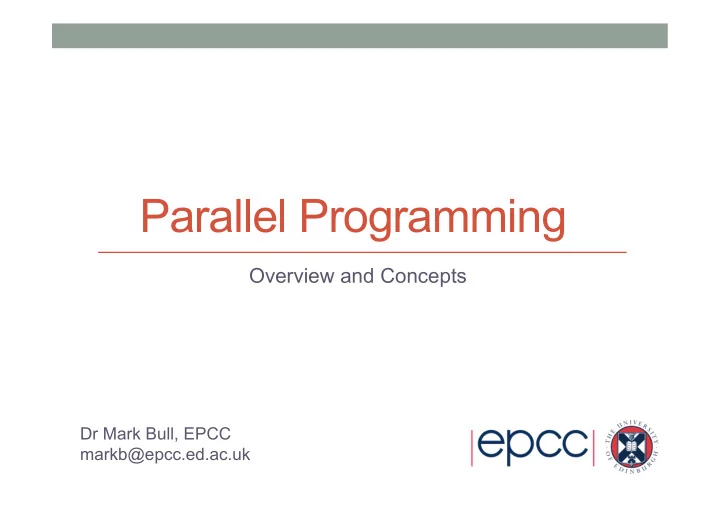

Parallel Programming Overview and Concepts Dr Mark Bull, EPCC markb@epcc.ed.ac.uk
Outline • Why use parallel programming? • Parallel models for HPC • Shared memory (thread-based) • Message-passing (process-based) • Other models • Assessing parallel performance: scaling • Strong scaling • Weak scaling • Limits to parallelism • Amdahl’s Law • Gustafson’s Law
Why use parallel programming? It is harder than serial so why bother?
Drivers for parallel programming • Traditionally, the driver for parallel programming was that a single core alone could not provide the time-to-solution required for complex simulations • Multiple cores were tied together as a HPC machine • This is the origin of HPC and explains the symbiosis of HPC and parallel programming • Recently, due to the physical limits on the increase in power of single cores, the driver is due to the fact that all modern processors are parallel • In effect, parallel programming is required for all computing, not just HPC
Focus on HPC • In HPC, the driver is the same as always • Need to run complex simulations with a reasonable time to solution • Single core or even single/multiple processors in a workstation do not provide the compute/memory/IO performance required • Solution is to harness the power of multiple cores/ memory/storage simultaneously • In order to do this we require concepts to allow us to exploit the resources in a parallel manner • Hence, parallel programming • Over time a number of different parallel programming models have emerged.
Parallel models How can we write parallel programs
Shared-memory programming • Shared memory programming is usually based on threads • Although some hardware/software allows processes to be programmed as if they share memory • Sometimes known as Symmetric Multi-processing (SMP) although this term is now a little old-fashioned • Most often used for Data Parallelism • Each thread operates the same set of instructions on a separate portion of the data • More difficult to use for Task Parallelism • Each thread performs a different set of instructions
Shared-memory concepts • Threads “communicate” by having access to the same memory space • Any thread can alter any bit of data • No explicit communications between the parallel tasks
Advantages and disadvantages • Advantages: • Conceptually simple • Usually minor modifications to existing code • Often very portable to different architectures • Disadvantages • Difficult to implement task-based parallelism – lack of flexibility • Often does not scale very well • Requires a large amount of inherent data parallelism (e.g. large arrays) to be effective • Can be surprisingly difficult to get good performance
Message-passing programming • Message passing programming is process-based • Processes running simultaneously communicate by exchanging messages • Messages can be 2-sided – both sender and receiver are involved in the process • Or they can be 1-sided – only the sender or receiver is involved • Used for both data and task parallelism • In fact, most message passing programs employ a mixture of data and task parallelism
Message-passing concepts • Each process does not have access to another process’s memory • Communication is usually explicit
Advantages and disadvantages • Advantages: • Flexible – almost any parallel algorithm imaginable can be implemented • Scaling usually only limited by your choice of algorithm • Portable – MPI library is provided on all HPC platforms • Disadvantages • Parallel routines usually become part of the program due to explicit nature of communications • Can be a large task to retrofit into existing code • May not give optimum performance on shared-memory machines • Can be difficult to scale to very large numbers of processes (>100,000) due to overheads
Scaling Assessing parallel performance
Scaling • Scaling is how the performance of a parallel application changes as the number of parallel processes/threads is increased • There are two different types of scaling: • Strong Scaling – total problem size stays the same as the number of parallel elements increases • Weak Scaling – the problem size increases at the same rate as the number of parallel elements, keeping the amount of work per element the same • Strong scaling is generally more useful and more difficult to achieve than weak scaling
Limits to parallel performance How much can you gain from parallelism
Performance improvement • Two theoretical descriptions of the limits to parallel performance improvement are useful to consider: • Amdahl’s Law – how much improvement is possible for a fixed problem size given more cores • Gustafson’s Law – how much improvement is possible given a fixed amount of time and given more cores
Amdahl’s Law • Performance improvement from parallelisation is strongly limited by serial portion of the code • As the serial part’s performance is not increased by adding more processes/threads • Based on having a fixed problem size • For example, 90% parallelisable ( P =0.9): • S(16) = 6.4 • S(1024) = 9.9
Amdahl’s Law
Gustafson’s Law • If you can increase the amount of work done by each process/task then the serial component will not dominate • Increase the problem size to maintain scaling • This can be in terms of adding extra complexity or increasing the overall problem size. • For example, 90% parallelisable ( P =0.9): • S(16) = 14.5 • S(1024) = 921.7
Gustafson’s Law
Summary
Recommend
More recommend